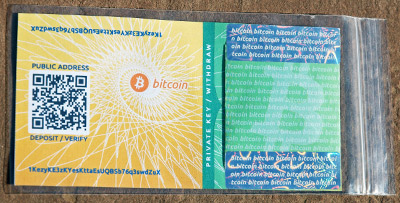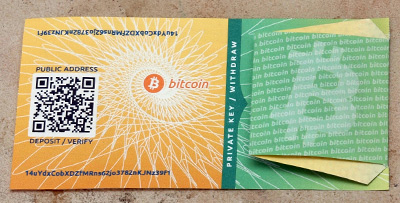Welcome! Let's print out a beautiful and secure wallet for your bitcoins.
Here's an overview of what will happen, step by step.Select your wallet design or language here:

Basic security checklist:
- ? Are you using a secure operating system guaranteed to be free of spyware and viruses, for example, an Ubuntu LiveCD?
Before printing out a wallet you'll need to "calibrate" your output using the zoom and horizontal shift adjustments to accommodate your particular browser / printer combination. Without proper callibration, your wallet may print out too small or with a misaligned reverse side.
Step 2: Print Front
Next you will print out the front side of your wallet. A public address and private key will automatically be generated, or you can supply your own key by rolling dice, shuffling cards, etc. It is also possible to duplicate an existing paper wallet or provide a "vanity" address if you have one.
Step 3: Print Back
Then you will put the same page back in your printer (but flipped over) to print out the back side of your wallet. This isn't just for good looks: the back side design includes additional tamper-resistant safeguards.
Step 4: Cut, Fold, Seal & Fund
Find your scissors! The final step is to cut out your wallet, fold it, and seal it with opaque (light-blocking) tape. Now you're ready to transfer bitcoins from your online holdings to your new wallet.
90 second tutorial video on YouTube »
Purchase hologram stickers and/or zip-sealing bags »
The calibration step helps line up the front and back sides of your printout. Print out this page in LANDSCAPE (wide) format. Based on the results, adjust the "zoom" and "horizontal shift" until your printed ruler (1) approximates a real ruler, and (2) is horizontally centered, leaving approximately equal margins on the left and right sides of the page.
What settings worked best for you? Feedback form »

About "BIP38" Encryption
The advantage to encrypting your paper wallet is that if your paper wallet is stolen or otherwise exposed, the balance on the wallet is safe unless the passphrase used to encrypt the wallet is guessed. However, if you encrypt your private key with BIP38 and you lose your passphrase, it will be impossible for you to recover the funds you have sent to this wallet.
Also, note that not many bitcoin wallet applications or web services are able to import BIP38 private keys. In this case, you will have to use the "Validate" feature on this webpage to extract the unencrypted Wallet Import Format (WIF) key as an intermediate step before sweeping the balance.
WARNING: Before sending any funds to a BIP38-encrypted wallet, first do a test make sure you are able to decrypt the printed private key back to ordinary WIF format.
In short, if you do not have a strong understanding of the BIP38 encryption and decryption workflow, click cancel, print your paper wallet out without encryption, and keep it safe the same way you would jewels or cash.
Reload the front page into your printer first. Note: The back design is intentionally larger than the front side. (Use the front side as your guide when cutting to trim off the excess.)
Print Wallet Back
How to cut & fold your 2-sided wallet:



Now fold the more narrow private key area in half, and then over again as indicated by the dotted lines in this diagram. The unusual "butterfly" shape can be a bit of a pain to cut out, but it's essential to keep your private key safe.
The final wallet will be a rectangle shape with the more narrow private key area folded over it.
Seal your wallet by placing two strips of sturdy light-blocking tape over the top and bottom edges of the private (folded) area. A zip-seal bag will keep it safe from moisture (especially important for inkjet prints.)
Purchase hologram stickers and/or zip-sealing bags »
How to add funds to your wallet:
Send bitcoins to the address (or QR code) where your wallet says "PUBLIC ADDRESS".How to withdraw funds from your wallet:
You should expect to withdraw the entire balance of the wallet by importing it (or "sweeping" it) to a live wallet, e.g. a Bitcoin wallet application or online service like blockchain.info or coinbase.com.If you elected to BIP38-encrypt your wallet, you may need to recover your unencrypted WIF "Wallet Import Format" private key by using the "validate" tab on this web page.
Visit BitcoinPaperWallet.com for detailed information on adding to and spending from a paper wallet »
Validate or decrypt private key
Enter or scan any private key into this form to display all available details in various formats. If your private key decodes properly, then you have verified that you should be able to retrieve any funds sent to that wallet. This should work for private keys generated by BitcoinPaperWallet.com as well as any other Bitcoin service.
For example, if you have a wallet encrypted with a BIP38 passphrase, you can use this form to decrypt your private key and retrieve the standard Wallet Import Format (WIF) key suitable for wallet software and services that don't directly support BIP38 importing.
You may also enter a passphrase (or "brain wallet") to see the corresponding SHA256 hashed keys.
Scan QR code using your camera
Permission denied. Your browser should display a message requesting access to your camera. Please click the "Allow" button to enable the camera.
If you are using Chrome and you launched this generator by opening the HTML file from your own computer "locally", you may need to launch Chrome from the command line and specify the --allow-file-access-from-files flag. Or you can set up a local web server (Apache) and run this generator via http://127.0.0.1... or, give up and just use Firefox.
Public and private details for:
This private key is a unique number that you should keep secret since it can be used to spend any bitcoins that have been sent to the corresponding public key. Keys can be encoded in a number of different formats. Look below for the most popular encoding formats (WIF, WIFC, HEX, B64, MINI).
Bitcoin v0.6+ stores public keys in compressed format. The client now also supports import and export of private keys with importprivkey/dumpprivkey. The format of the exported private key is determined by whether the address was generated in an old or new wallet.
51 characters base58, starts with a '5'
52 characters base58, starts with a 'K' or 'L'